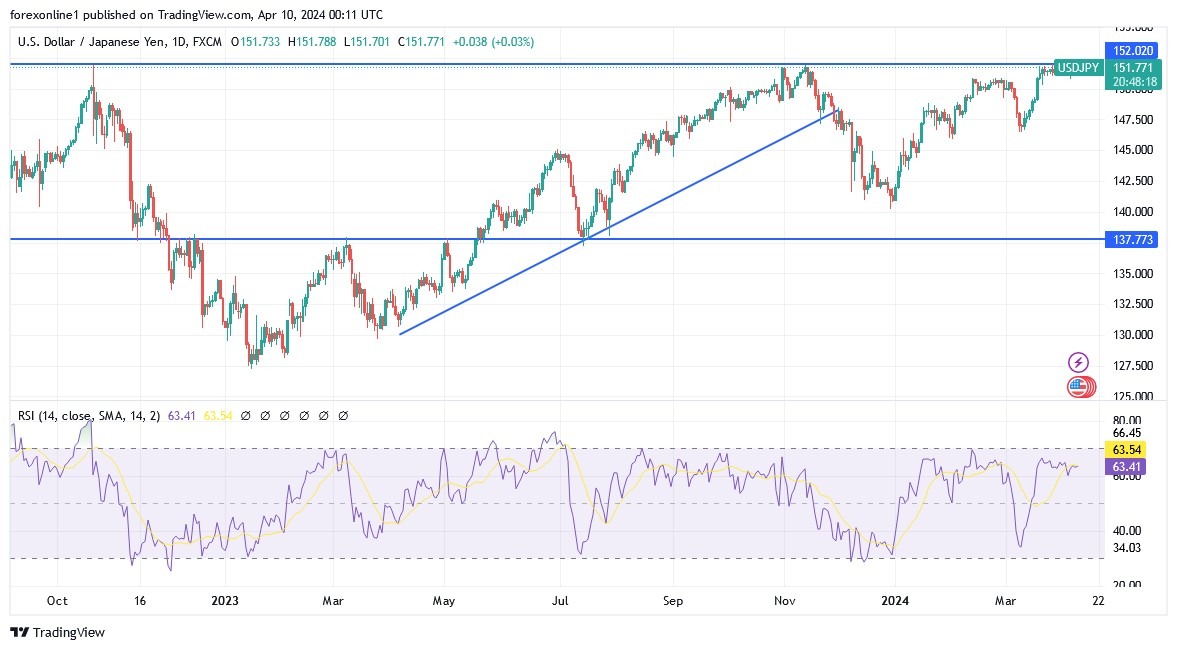- The value of the Japanese yen fell to around 152 yen per US dollar, hovering near its lowest level in several decades, prompting Japanese authorities to intervene verbally again.
- The USD/JPY pair is stable around 151.70 at the time of writing the analysis and before the announcement of the important US inflation figures.
On the front of Japan's policy towards the collapse of the yen exchange rate, Japanese Finance Minister Shunichi Suzuki said on Tuesday that the authorities will not rule out taking any measures to deal with excessive yen movements, repeating the warnings in his previous statements. For his part, Bank of Japan Governor Kazuo Ueda also said that the Bank of Japan should consider reducing the degree of monetary stimulus if the inflation trend continues to accelerate.
In general, the recent weakness of the yen came amid speculation that the Bank of Japan's monetary policy will remain accommodative for some time, despite the recent shift against negative interest rates. Externally, the currency has also come under pressure from strong US economic data and hawkish comments from Federal Reserve officials.
Top Forex Brokers
What is expected for the yen exchange rate in the near future?
According to forex trading platforms, the USD/JPY currency pair has stabilized on the threshold of the 152.00 resistance level. The yen is expected to trade at 153.53 by the end of this quarter, according to global macroeconomic models and analyst expectations. Looking ahead, we expect it to trade at 160.16 in 12 months.
Before the announcement of the important US inflation figures, the most influential banker in the United States, Jamie Dimon, CEO of JPMorgan Chase, told investors on Monday that he still expects the US economy to be resilient and grow this year. However, he is concerned that geopolitical events, including the war in Ukraine and the war between Israel and Hamas. American political polarization, could create an environment that "could create risks that could surpass anything since World War II."
The comments came in an annual letter to shareholders from Dimon, which often uses the letter to weigh in on broad topics such as policy, regulation, global events and what that might mean for JPMorgan Chase, as well as the broader economy. Concurrently, Dimon also used his message to forcefully defend the company's diversity and equality efforts, pushing back on arguments from Republicans who say such efforts at Fortune 500 companies, colleges and universities are discriminatory and promote leftist ideology.
Particularly, Dimon had concerns about the continued large-scale deficit spending by the US government and other countries. Also, the need for countries like the US to rearm and continue to build green infrastructure, all of which are expected to keep inflation higher than investors expect. Because of these issues, Dimon said he is less optimistic that the US economy will achieve a "soft landing," which he described as modest growth alongside falling inflation and interest rates, compared to the broader market. Meanwhile, he says investors are pricing in a "70% to 80%" chance of a soft landing, Dimon believes the chances of such an ideal outcome are "much lower" than that.
Also, at a time when some investors and economists are questioning whether the Fed can meet its forecast of three US interest rate cuts this year, Dimon warned of the possibility of interest rates rising to 8% or higher. Furthermore, The Federal Reserve's benchmark interest rate currently ranges from 5.25% to 5.50%. At the same time, Dimon of JP Morgan warns of inflation, political polarization, and wars that create risks not seen since World War II.
USD/JPY Technical analysis and Expectations Today:
The general trend for the USD/JPY pair remains bullish, and it will continue to perform as such until Japanese intervention in the markets occurs to prevent further depreciation of the Japanese yen exchange rate. Therefore, the best-selling opportunity is from the top, especially from resistance levels at 152.75 and 153.30, respectively, but without taking risks. Moreover, the anticipated Japanese intervention in the markets may bring strong selling operations for the dollar against the Japanese yen, leading to a shift in direction towards bearishness. Especially, if it quickly returns to support levels at 149.80 and 148.00, respectively. Ultimately, taking into consideration that the future policies of central banks, particularly the US Federal Reserve, will determine the fate of the currency pair's gains.
Ready to trade our Forex daily forecast? We’ve shortlisted the best currency trading platforms in the industry for you.


